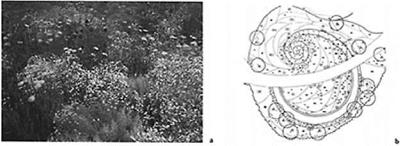There has, until recently, been little application of this approach in non-woody or herbaceous plantings, and virtually no application (be it with woody or non-woody plants) in ornamental plantings. However, in the late 1990s, a series of research projects, based primarily in Germany, Austria and Switzerland, began to explore random mixtures as a basis for setting out perennial plantings. The trials are now finding their way into public landscapes, supported enthusiastically by sectors of the nursery industry that see this approach as opening up potentially important new markets.
Essentially, the aim behind these mixes is to provide ecologically and aesthetically compatible mixtures of perennials that suit particular environmental conditions and which respond to simple ‘extensive’ maintenance techniques. One of their main selling points is that, compared to the standard planting design and implementation process, they are relatively cheap and straightforward to install. This is partly because there is no need for the drawing up of a detailed
Table 9.1. Properties of different structural types in random planting
Number: 100 m2 Type
1-5 Emerging perennials
10-50 Companion perennials
30-80 Ground-covering perennials
30-300 Scattered perennials planting plan: the plantings are established using a specification not dissimilar to that of the woody plant mixes discussed above. As a result, there is a design cost-saving and because the plantings do not necessarily require great skill and knowledge to set out, and because they are simple to maintain, they potentially offer much scope to extend the use of high-quality naturalistic plantings in public places.
Although different structural plant types might be planted at different distances from each other, in all other respects, planting in these mixture-based perennial systems is entirely random. It is purely a matter of chance whether one species or cultivar fills a particular planting position or another does. As such, mixture planting has been heavily criticised by some landscape designers and horticulturists as representing a diminution of the worth or value of the designer. True, the traditional skills of placing individuals or groups of different species in studied compositions or associations for aesthetic effect are no longer valid, but this is not to say that artistic or creative vision is not important in such plantings. On the contrary, there is still a great need for aesthetic considerations, but additional skills and knowledge are also important for such mixtures to be successful.
It is also necessary to go beyond Plant Sociability as the basis of the planting. Yes, this remains an important factor, but it is also necessary to have a stronger ecological basis for plant selection. Some of the factors to take into account in formulating perennial mixtures include:
– the habitat requirements of the component species
– life history—the inclusion of short-lived rapidly flowering ephemeral species as well as
slowergrowing longer-lived species ensures a dynamic development of the mixtures over the long-term, as well as flowering display from the earliest stages
– ecological strategy—matching species according to their competitive compatibility, for
example through the use of Grime’s plant strategy classification (see Chapter 4)
– regeneration—what might be the long-term dynamic characteristics of the planting and
how will species persist and regenerate into the long term (if required)?
– aesthetic characteristics—working towards harmony or contrast in colour associations,
for example
– structural characteristics—application of the principles of Garden Habitat planting in
terms of the balance between different structural plant types
– phenology—ensuring a compatible mix of species in terms of flowering time and
pattern of growth throughout the year
– maintenance intensity—are the species compatible with the anticipated intensity of
maintenance?
Through repeated trials, one of the co-authors of this chapter (Wolfram Kircher) has found that the proportions in Table 9.1 of different structural types generally give satisfactory results in a random planting. The figures in Table 9.1 are for 100 m2 of planting.
The mixture planting method can be used as the basis for the design of new and original plantings but, in Germany and Switzerland, it has also been used as the basis for planting ‘recipes’ that can be applied ‘off the shelf’ in any location, provided that soil conditions and climate are correct for that particular mixture. For example, the ‘Silver Summer’
|
|
9.13
(a) A ‘Silver Summer’ planting,
Bernberg, Germany; (b) A mixed planting by the landscape practice LandArt
mixture (Figure 9.13) is suited to sunny, warm conditions over free-draining soils.
Whilst in many cases it is true to assert that ‘the arbitrary planting of a great many randomly chosen perennials can never lead to satisfactory results’ (Hansen and Stahl 1993), if the above factors are considered it is likely that a well-chosen randomly planted mixture will not produce results that are greatly different from a carefully worked-out naturalistic scheme. Figure 9.14 shows the results of an independent visual assessment of the same group of perennial ‘Silver Summer’ species that have been either randomly planted in drift or blocks, or planted according to a ‘garden habitat’ scheme based upon their sociability characteristics. The randomly planted mixture receives higher average scores. The difference in summer scores hardly repays the extra effort in working out a detailed planting plan.




